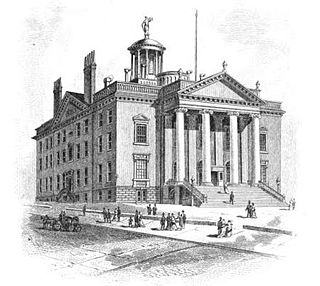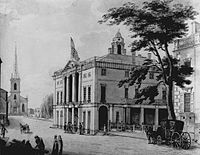Background
Under the provisions of the New York Constitution of 1777, the state senators were elected on general tickets in the senatorial districts, and were then divided into four classes. Six senators each drew lots for a term of 1, 2, 3 or 4 years and, beginning at the election in April 1778, every year six Senate seats came up for election to a four-year term. Assemblymen were elected countywide on general tickets to a one-year term, the whole assembly being renewed annually.
In March 1786, the legislature enacted that future legislatures meet on the first Tuesday of January of each year unless called earlier by the governor. No general meeting place was determined, leaving it to each Legislature to name the place where to reconvene, and if no place could be agreed upon, the legislature should meet again where it adjourned.
On February 7, 1791, the Legislature re-apportioned the Senate and Assembly districts, according to the figures of the 1790 United States census.
State Senator Peter Schuyler died on January 4, 1792, leaving a vacancy in the Western District.
At this time the politicians were divided into two opposing political parties: the Federalists and the Democratic-Republicans. [1] Since the first appearance of the political parties, many politicians changed sides for a variety of reasons, but the highly controversial gubernatorial election of 1792 re-aligned the politicians more clearly.
Sessions
This time, the legislature was called to meet early to elect presidential electors. Both Houses met at Federal Hall in New York City; assembled a quorum on November 6, 1792; and adjourned on March 12, 1793.
On November 20, 1792, the legislature chose 12 presidential electors: William Floyd, Samuel Osgood, Edward Savage, Stephen Ward, John Bay, Jesse Woodhull, David Van Ness, Johannes Bruyn, Volkert Veeder, Abraham Yates Jr., Samuel Clark and Abraham Ten Eyck. All were Democratic-Republicans, elected on the first ballot in both Houses, and all cast their votes for George Washington and Gov. George Clinton. [3]
After the 1790 United States census, Congress re-apportioned the seats, increasing New York's representation from 6 to 10 seats. This required the legislature to re-apportion the congressional districts in the State what was belatedly done on December 18, 1792. Subsequently, the congressional elections were held in January 1793.

The 14th New York State Legislature, consisting of the New York State Senate and the New York State Assembly, met from January 5 to March 24, 1791, during the fourteenth year of George Clinton's governorship, in New York City.

The 15th New York State Legislature, consisting of the New York State Senate and the New York State Assembly, met from January 5 to April 12, 1792, during the fifteenth year of George Clinton's governorship, in New York City.

The 17th New York State Legislature, consisting of the New York State Senate and the New York State Assembly, met from January 7 to March 27, 1794, during the seventeenth year of George Clinton's governorship, in Albany.

The 18th New York State Legislature, consisting of the New York State Senate and the New York State Assembly, met from January 6 to April 9, 1795, during the eighteenth year of George Clinton's governorship, first in Poughkeepsie, then in New York City.

The 19th New York State Legislature, consisting of the New York State Senate and the New York State Assembly, met from January 6 to April 11, 1796, during the first year of John Jay's governorship, in New York City.

The 20th New York State Legislature, consisting of the New York State Senate and the New York State Assembly, met from November 1, 1796, to April 3, 1797, during the second year of John Jay's governorship, first in New York City, then in Albany.

The 21st New York State Legislature, consisting of the New York State Senate and the New York State Assembly, met from January 2 to April 6, 1798, during the third year of John Jay's governorship, in Albany.

The 22nd New York State Legislature, consisting of the New York State Senate and the New York State Assembly, met from August 9, 1798, to April 3, 1799, during the fourth year of John Jay's governorship, in Albany.

The 23rd New York State Legislature, consisting of the New York State Senate and the New York State Assembly, met from January 28 to April 8, 1800, during the fifth year of John Jay's governorship, in Albany.

The 25th New York State Legislature, consisting of the New York State Senate and the New York State Assembly, met from January 26 to April 5, 1802, during the first year of George Clinton's second tenure as Governor of New York, in Albany.

The 27th New York State Legislature, consisting of the New York State Senate and the New York State Assembly, met from January 31 to April 11, 1804, during the third year of George Clinton's second tenure as Governor of New York, in Albany.

The 28th New York State Legislature, consisting of the New York State Senate and the New York State Assembly, met from November 6, 1804, to April 10, 1805, during the first year of Morgan Lewis's governorship, in Albany.

The 31st New York State Legislature, consisting of the New York State Senate and the New York State Assembly, met from January 26 to April 11, 1808, during the first year of Daniel D. Tompkins's governorship, in Albany.

The 32nd New York State Legislature, consisting of the New York State Senate and the New York State Assembly, met from November 1, 1808, to March 30, 1809, during the second year of Daniel D. Tompkins's governorship, in Albany.

The 34th New York State Legislature, consisting of the New York State Senate and the New York State Assembly, met from January 29 to April 9, 1811, during the fourth year of Daniel D. Tompkins's governorship, in Albany.

The 36th New York State Legislature, consisting of the New York State Senate and the New York State Assembly, met from November 3, 1812, to April 13, 1813, during the sixth year of Daniel D. Tompkins's governorship, in Albany.

The 38th New York State Legislature, consisting of the New York State Senate and the New York State Assembly, met from September 26, 1814, to April 18, 1815, during the eighth year of Daniel D. Tompkins's governorship, in Albany.

The 43rd New York State Legislature, consisting of the New York State Senate and the New York State Assembly, met from January 4 to April 14, 1820, during the third year of DeWitt Clinton's governorship, in Albany.

The 45th New York State Legislature, consisting of the New York State Senate and the New York State Assembly, met from January 2 to April 17, 1822, during the fifth year of DeWitt Clinton's governorship, in Albany.

The 46th New York State Legislature, consisting of the New York State Senate and the New York State Assembly, met from January 7 to April 24, 1823, during the first year of Joseph C. Yates's governorship, in Albany.




